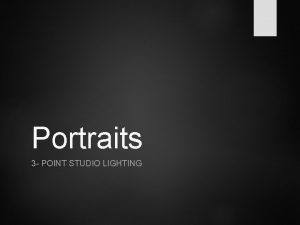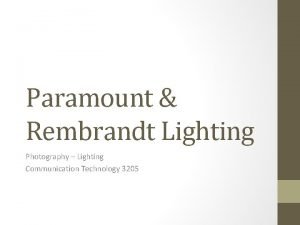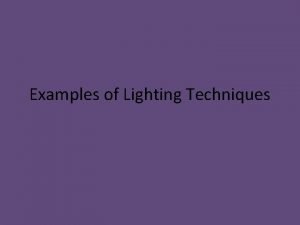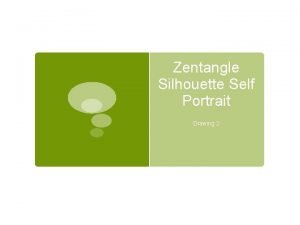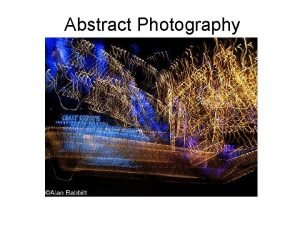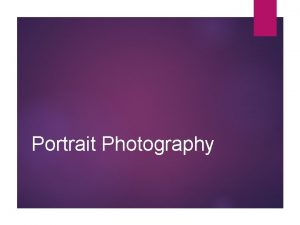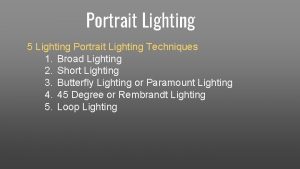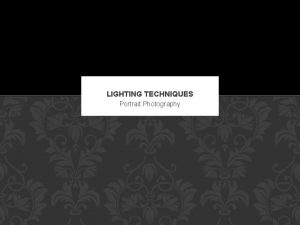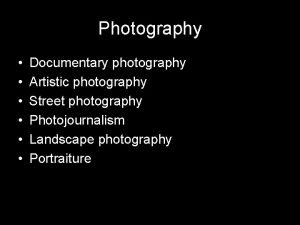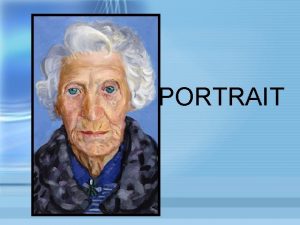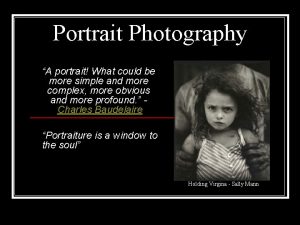Lighting Patterns for Portrait Photography This resource is








- Slides: 8

Lighting Patterns for Portrait Photography This resource is included in TATA’s COVID 19 visual art resources collection with appreciation and permission from its creator, Kate Camm, of Elizabeth College Tasmania. TATA does not have ownership of the IP (Intellectual Property) contained within the resources shared on this website. TATA acknowledges the generosity of sharing practice that underpins this collaborative resource sharing space, and ask that any on-sharing of resources acknowledge the originating IP of the Arts/Education professional/s who have contributed this resource, as well as any third party content acknowledged therein April 10 th, 2020 Courtesy of Miriam Berkery, The Friends School, https: //tata. org. au/

For this task shoot in Monochrome (black and white). This will help you to concentrate on composition and lighting whilst not being distracted by colour.

Split Lighting splits the face exactly into equal halves with one side being in the light, and the other in shadow. It is often used to create dramatic images for things such as a portrait of a musician or an artist.

Loop Lighting Loop lighting is made by creating a small shadow of the subjects noses on their cheeks. To create loop lighting, the light source must be slightly higher than eye level and about 30 -45 degrees from the camera. Loop light is probably the most common or popular lighting pattern as it is easy to create and flatters most people.

Rembrandt Lighting Rembrandt lighting is so named because the Rembrandt the painter often used this pattern of light in his paintings, as you can see in his self portrait here. Rembrandt lighting is identified by the triangle of light on the cheek. Unlike loop lighting where the shadow of the nose and cheek do not touch, in Rembrandt lighting they do meet which, creates that trapped little triangle of light in the middle. To create proper Rembrandt lighting make sure the eye on the shadow side of the face has light in it and has a catch light, otherwise the eye will be “dead” and not have a nice sparkle. Rembrandt lighting is more dramatic, so like split lighting it creates more mood and a darker feel to your image.

Butterfly Lighting Butterfly lighting is aptly named for the butterfly shaped shadow that is created under the nose by placing the main light source above and directly behind the camera. The photographer is basically shooting underneath the light source for this pattern. It is most often used for glamour style shots and to create shadows under the cheeks and chin. It is also flattering for older subjects as it emphasizes wrinkles less than side lighting. Butterfly lighting is created by having the light source directly behind the camera and slightly above eye or head level of the subject

Broad Lighting Broad lighting is when the subject’s face is slightly turned away from centre, and the side of the face which is toward the camera (is broader) is in the light. This produces a larger area of light on the face, and a shadow side which appears smaller.

Short lighting is the opposite of broad lighting. As you can see by the example here, short lighting puts the side turned towards the camera (that which appears larger) in more shadow. It is often used for low key, or darker portraits. In short lighting, the face is turned towards the light source this time. Notice how the part of the face that is turned away from the camera has the most light on it and the shadows are falling on the near side of the face, closet to the camera.
